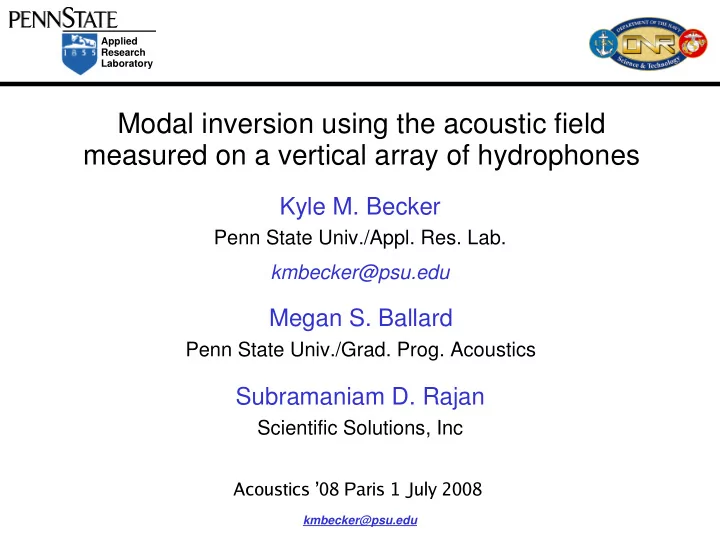

Applied Research Laboratory Modal inversion using the acoustic field measured on a vertical array of hydrophones Kyle M. Becker Penn State Univ./Appl. Res. Lab. kmbecker@psu.edu Megan S. Ballard Penn State Univ./Grad. Prog. Acoustics Subramaniam D. Rajan Scientific Solutions, Inc Acoustics ’08 Paris 1 July 2008 kmbecker@psu.edu
Measurement & Analysis Objectives Applied Research Laboratory ● Collect data appropriate for testing and validating geo- acoustic inversion schemes based on normal modes ● Obtain geospatially dependent sediment parameter estimates - mapping ● Exploit Doppler shift in a waveguide to infer geo- acoustic parameters and interpret results ● Compare inversion results obtained for co-located assets but different measurements and algorithms ● Investigate impact of water column variability on geo- acoustic parameter estimation kmbecker@psu.edu
Primary Measurement Assets Applied Research Laboratory J-15-3 LF source – Starboard J-Frame CW comb (50,75,125, 175 Hz) Radial tows ~5 km out/back on VLA FM sweep (40-290 Hz) 15 km standoff, 0.5s on/2.5s off ~173 dB re 1uPa/1m SL Towed CTD chain Temporal/spatial measure of C,T,P. 48 sensors 141 m vertical aperture (3 * meter spacing) NOT fully deployed during MIME kmbecker@psu.edu
Broadband Data Applied Research Laboratory • 0.5 sec. sweep (250 Hz) • ~15 km from VLA kmbecker@psu.edu
Perturbative Inverse - Time Applied Research Laboratory ∞ ∂ ∆ θ ∂ ω ∆ r 2 1 c ( s , z ) ∫∫ = = φ ω 2 n dt ( s , z , ) dsdz ∂ϖ ∂ω ω ρ n n 3 k ( ) c ( s , z ) ( s , z ) n 0 0 Time-Frequency Analysis Geospatial Regions kmbecker@psu.edu
Perturbative Inverse - Time Applied Research Laboratory Geospatially distributed inversion Model validation No low-speed layer – only 3 modes used in inversion kmbecker@psu.edu
Synthetic Aperture Processing Applied Research Laboratory Range ¥ i p e 4 ò - = ik r ˆ ˆ g k r z z ( ; , , ) w r r p r z z ( ; ) ( ; , ) re dr r r 0 L 0 2 k p - ¥ r 2 T s = p P = å AR x a x - 2 + å p - i 2 fkT n k n k p 1 a e = k = k 1 k 1 kmbecker@psu.edu
Synthetic Aperture Data Applied Research Laboratory • 16 depths • out and back • 5 speeds kmbecker@psu.edu
Perturbative Inverse – Wavenumber Applied Research Laboratory Partial Data Wavenumber Perturbation Equation ¥ D 1 c z ( ) - ò D = 1 2 2 k ( ) z Z ( ) z k ( ) z dz r n n k c z ( ) n 0 0 kmbecker@psu.edu
Perturbative Inverse - Wavenumber Applied Research Laboratory • All modes used • Low speed layer resolved kmbecker@psu.edu
Synthesis of Results - Preliminary Applied Research Laboratory Comparison of profiles obtained by other investigators Geospatial Regions Presence of Low-speed layer is suggested in 2 of 4 results kmbecker@psu.edu
Doppler Shift in a Waveguide Applied Research Laboratory Objective: Measure frequency and wavenumber Doppler shifts on synthetic aperture created by moving source and stationary receiver to infer model group velocity 1 ∫ ω ≈ Ω ω ( 1 ) p ( r , z , ) S ( ) g ( k , z , ) H ( k r ) k dk k r 0 r r r 2 − v s Ω = ω 1 k c Ω d = k v Modal group velocity is given by: gn dk n Evaluating the modal pressure field at the Doppler shifted frequencies, the differential can be evaluated to estimate group velocity [Ref: H Schmidt and W.A. Kuperman, JASA 96 (1) pp386-395 (1994)] kmbecker@psu.edu
Doppler Shift in a Waveguide – d Ω / dk n Applied Research Laboratory Doppler Shift in a Waveguide Field generated at 10 different freqs. Corresponding to Doppler shift for Source moving Plus/minus 5 m/s. Horizontal wave- Numbers estimated And differential Determined. Estimates compared To group velocity At 50 Hz (KRAKEN) kmbecker@psu.edu
Doppler Shift in a Waveguide - d Ω Applied Research Laboratory Frequency Observed at VLA Tow Speed -8 to +8 m/s 2 m/s per div. kmbecker@psu.edu
Doppler Shift in a Waveguide – d Ω / dk n Applied Research Laboratory • Doppler prop. Speed & symmetric • BW prop to time app. • Modal content equiv. • k n shift symmetry, but incorrect kmbecker@psu.edu
Doppler Shift in a Waveguide – d Ω / dk n Applied Research Laboratory • Wavenumber shift should increase with increasing Doppler • Measurements indicate decreasing shift in wrong direction / 1 m/s \/ 2 m/s \/ 3 m/s \/ 4 m/s \/ 5 m/s \ • Unresolved cause of shift – not observed in previous data sets • Asynchronous data collection may be cause kmbecker@psu.edu
Doppler Shift in a Waveguide – dk n Applied Research Laboratory kmbecker@psu.edu
Doppler Shift – Dispersion Analysis Applied Research Laboratory Possibility to obtain full dispersion representation from Doppler shift about small number of discrete transmit frequencies? For half-space – simple dispersion can be approximated kmbecker@psu.edu
Doppler Shift – Dispersion Analysis Applied Research Laboratory Dispersion for Wavenumber and Travel Time Inversions 3 modes kmbecker@psu.edu
Doppler Shift – Dispersion Analysis Applied Research Laboratory Dispersion for Wavenumber and Travel Time Inversions 5 modes kmbecker@psu.edu
Doppler Shift – Dispersion Analysis Applied Research Laboratory Dispersion for Wavenumber and Travel Time Inversions 7 modes kmbecker@psu.edu
Doppler Shift – Dispersion Analysis Applied Research Laboratory Group Speed for Wavenumber and Travel Time Inversions All modes Group speed max slow layer speed kmbecker@psu.edu
Summary Applied Research Laboratory ● Wavenumber and travel time inversions obtained for low-frequency acoustic measurements on VLA ● High Freq./Wavenumber analysis indicates slow- speed layer ● Dispersion characteristics for low-order modes similar ● Dispersion relationship for high-order modes has potential to validate presence of layer ● Doppler frequency shifts measurable for slow tow speeds ● Doppler wavenumber shift not consistent with physics - kmbecker@psu.edu undetermined range registration (asynch. clock) issue
Recommend
More recommend